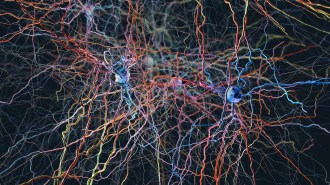Giggling rats help reveal how brain creates joy
To trace nerve cell response, researcher spent three years tickling rodents

GOOCHY GOOCHY GOO Rats seem to enjoy a good tickle, which activates nerve cells in a part of the brain that detects touch.
S. Ishiyama, Michael Brecht
- More than 2 years ago
Tickle a rat and it will jump for joy, gleefully squeak and beg for more. In addition to describing these delightful reactions to a tickling hand, a new study identifies nerve cells in the brain that help turn rats into squirmy puddles of giggles.
The results, published November 11 in Science, offer insight into how the brain creates glee, an understudied emotion. “People really underrate the positive things — fun, happiness, joy,” says study coauthor Shimpei Ishiyama of Humboldt University of Berlin.
Scientists knew that rats seemed to enjoy a good tickle from a human, but how the brain creates that emotion was a mystery. Although no protocol existed, the tickling part of the experiment turned out to be “surprisingly easy,” Ishiyama says. He simply stuck his hand in the cages and scribbled his fingers in the rats’ fur, to their apparent delight. Tickled rats laughed by emitting an ultrasonic 50-kilohertz giggle that humans can’t hear. They also jumped for joy, an acrobatic feat called “Freudensprünge,” and chased Ishiyama’s hand around the cage. Using laughter as a measurement, Ishiyama and colleagues found that the belly, not back or tail, is a rat’s most ticklish spot.
This joyful response may be created in part by nerve cells in the somatosensory cortex. In people, this brain region responds to tickles and is usually associated with touch perception. In tickled rats, many nerve cells in the part of the somatosensory cortex that corresponds to the rodents’ trunks grew active, electrodes revealed. A light stroke activated some of these nerve cells, but not as many.
Because these nerve cells respond to touch, it’s not surprising that they grew active during a tickle, Ishiyama says. But additional experiments found active nerve cells when the rats were chasing a tickling hand without being touched — suggesting the cells are responding to something specific about a tickle, not just touch in general. What’s more, when the researchers used electrodes to stimulate the somatosensory cortex in untouched rats, the rats giggled.
Watch a video of the giggling lab rats in action.
TICKLE ME, RAT Nerve cells in a rat’s somatosensory cortex respond to a tickling hand, action that may offer clues to how the brain creates joy, a new study proposes. S. Ishiyama & M. Brecht |
It turns out that ticklishness is a flighty state, and not just because some rats like to be tickled more than others. Anxious rats on a platform and in bright lights emitted fewer laughlike vocalizations than calm rats, the researchers found. Nerve cells in the somatosensory cortex were less likely to fire off signals, too, results that highlight just how mood-dependent tickling is.
The new study shows for the first time that laughter can result from stimulation of the somatosensory cortex, says neuroscientist Elise Wattendorf of the University of Fribourg in Switzerland. The brain area’s involvement in both the sensory aspects of tickling and its social context is “unexpected, and constitutes an outstanding result,” she wrote in an e-mail. Using brain scans, Wattendorf and colleagues had previously found that the somatosensory cortex was active when people laughed as they were tickled.
Many brain studies focus on troubles such as depression, Ishiyama says. But by taking the opposite approach, he hopes to reveal new insights into how the brain creates and maintains happiness. Besides, he says, “it’s also fun to study fun.”






